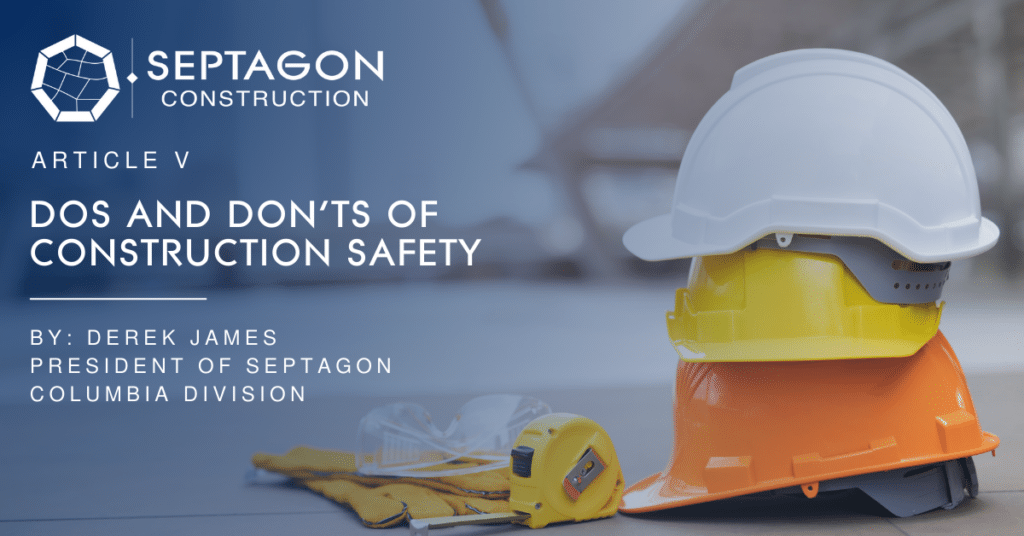Dos and Don’ts of Construction Safety

The Dos
ALWAYS WEAR SUITABLE PERSONAL PROTECTIVE EQUIPMENT
Wearing suitable personal protective equipment (PPE) such as hard hats, gloves, and safety goggles on a work site is crucial for ensuring the safety and well-being of workers. Hard hats protect against head injuries from falling objects, gloves safeguard hands from cuts and burns, and safety goggles shield the eyes from debris and chemicals. By consistently wearing PPE, workers reduce the risk of accidents and injuries, creating a safer environment for everyone involved. Employers should prioritize providing proper PPE and enforcing its use to promote a culture of safety in the workplace.
ADHERE TO SAFETY PROTOCOLS AND PROCEDURES
Adhering to safety protocols and procedures outlined in Septagon’s handbook and OSHA guidelines is crucial for maintaining a safe work environment. These measures are designed to protect employees from potential hazards and ensure their well-being while on the job. By following these guidelines, employees can reduce the risk of accidents, injuries, and illnesses, ultimately promoting a culture of safety within the workplace. It is important for all employees to familiarize themselves with these protocols, receive proper training, and actively participate in creating a safe and healthy work environment for everyone.
INSPECT TOOLS AND EQUIPMENT PRIOR TO USE
Before using any tools or equipment, it is crucial to inspect them to ensure they are in optimal working order. Checking for any damage, wear and tear, or missing parts can help prevent accidents and malfunctions during usage. This simple step can not only enhance safety but also improve efficiency by avoiding delays caused by faulty equipment. Regular maintenance and inspection of tools and equipment not only prolong their lifespan but also contribute to a smoother workflow and a safer working environment. By taking the time to inspect and maintain tools properly, you can ensure a productive and safe working environment for yourself and those around you.
The Dont’s
NEVER OVERLOOK WARNING SIGNS
It is crucial never to overlook warning signs or neglect existing safety regulations in any setting. These indicators are in place to protect individuals from potential harm or danger. By paying attention to warning signs and adhering to safety protocols, we can prevent accidents and ensure the well-being of ourselves and those around us. Ignoring these precautions can lead to serious consequences and jeopardize the safety of everyone involved. Therefore, it is essential to take these warnings seriously and follow safety guidelines to maintain a secure environment for all.
AVOID ENGAGING IN ANY RISKY BEHAVIORS
When on a construction site, it is crucial to avoid engaging in any behaviors that may cause unnecessary risks. This includes following safety protocols, wearing appropriate protective gear, and staying alert and focused at all times. Taking shortcuts or ignoring safety measures can lead to serious accidents and injuries. It is important to prioritize safety for yourself and others on the site by being mindful of your actions and surroundings. By being cautious and responsible, you can help create a safer work environment for everyone involved in the construction project.
NEVER OPERATE MACHINERY OR EQUIPMENT WITHOUT PROPER TRAINING OR AUTHORIZATION
Employees should always refrain from operating machinery or equipment without the necessary training or authorization to ensure their safety and the safety of others around them. Operating machinery without proper training can lead to accidents, injuries, or even fatalities. It is crucial for employees to understand the risks involved in using specific equipment and to know how to operate it correctly to prevent accidents. By following proper protocols and receiving the necessary training, employees can contribute to a safe work environment and avoid potentially dangerous situations. It is important for companies to provide adequate training to their employees to ensure that they are equipped with the knowledge and skills needed to operate machinery safely and effectively.
